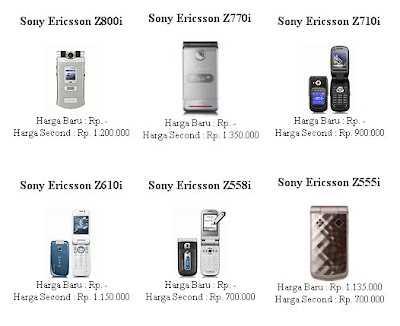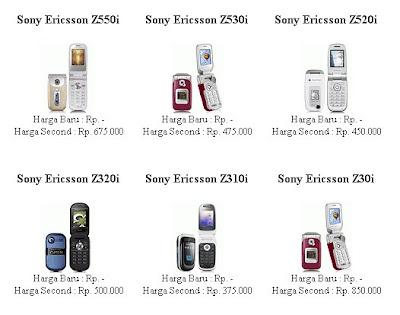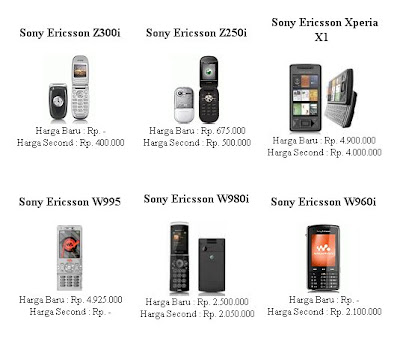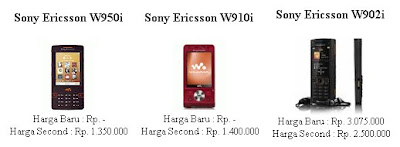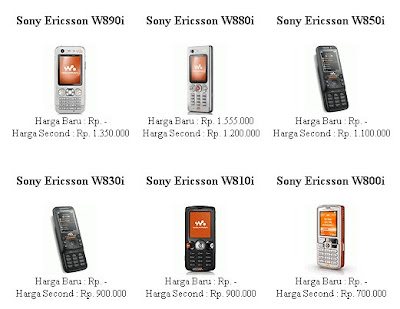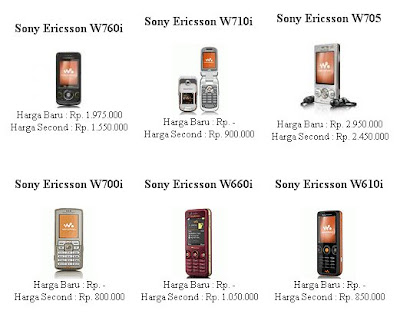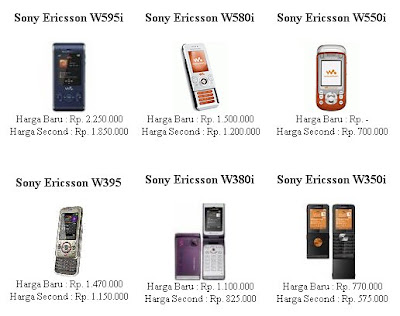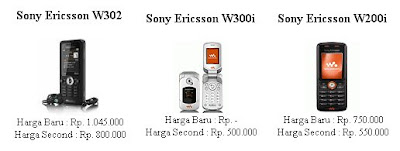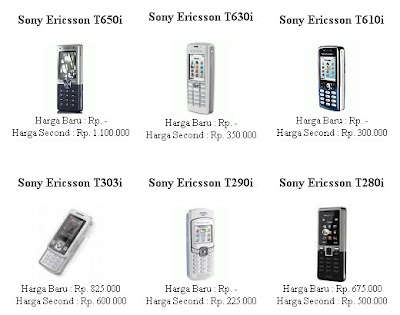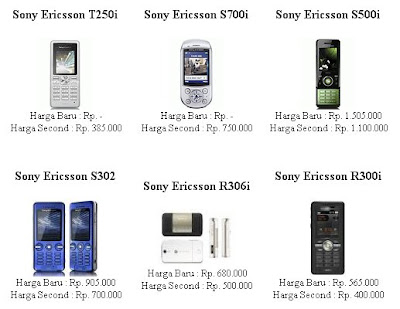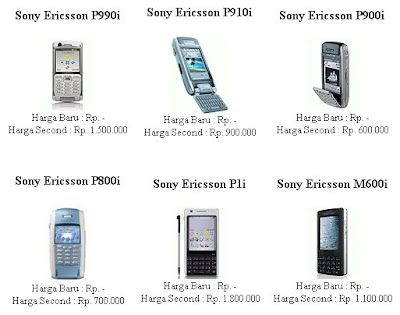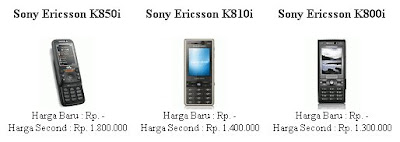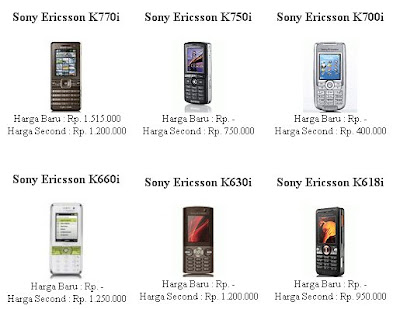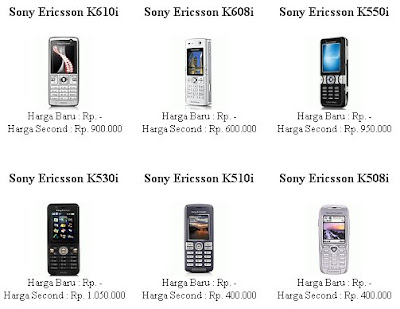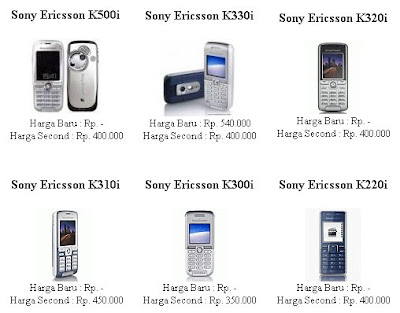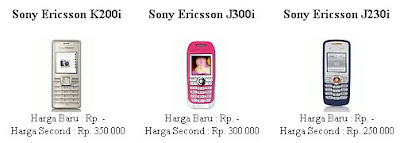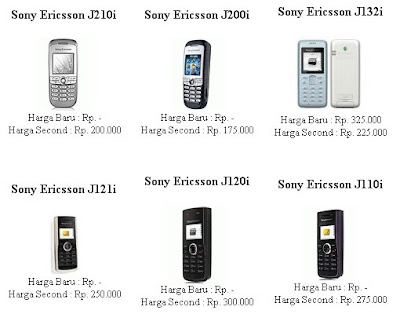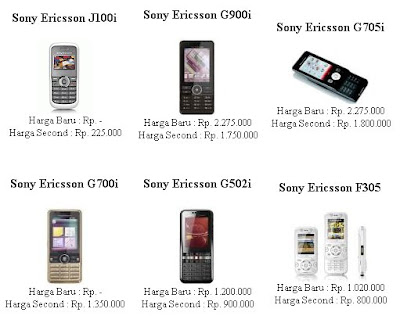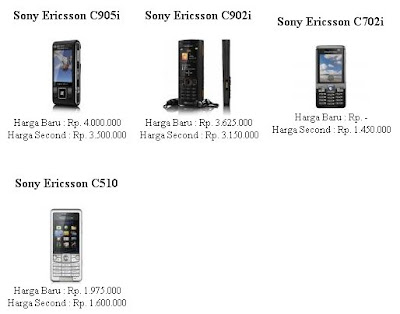Daftar Harga handphone nokia Juni 2010
















 NB : Update Harga handphone nokia Juli 2010, harga bisa berbeda-beda tiap daerah...
NB : Update Harga handphone nokia Juli 2010, harga bisa berbeda-beda tiap daerah...Cara Upgrade Firmware Sony Ericsson Via Internet :
Mungkin banyak di antara sobat yang pernah memiliki masalah dengan ponsel Sony Ericssonnya,
Seperti : Layar Lcd blank putih, tidak bisa masuk ke Menu, Menu kamera tidak berfungsi, Hank, dan masih banyak lainnya yang di sebabkan oleh Firmware Ponsel Sony ericsson tersebut yang bermasalah.jika malas membaca basi-basi dari saya langsung kebawah aja deh. hix hixs....(Lebay)...
Kerusakan pada ponsel ada dua macam :
Tahap pertama yaitu download dulu software Update_Service, bisa sobat download di www.sonyericsson.com, file yang didownload sebesar 34,1 Mb.(silahkan ngopi atau ngemil dulu sampai proses download selesai), jika file sudah selesai didownload silahkan double klik untuk menginstal di komputer sobat.

Setelah di instal beginilah tampilan awal dari program tersebut.
Tunggu beberapa saat....lalu tampilannya akan seperti ini
pada sisi kanan pilih bahasa indonesia untuk mempermudah proses upgrade. jangan lupa centang perjanjian Lisensi di box sebelah kiri bawah. lalu klik mulai. setelah itu pilih tipe ponsel yang sobat pakai. sebagai contoh saya akan mengupgrade ponsel SE K510i. yang bermasalah karena tidak bisa menyimpan foto. lalu tampilannya seperti ini.
Setelah itu akan keluar tampilan seperti ini.
Perhatikan dengan seksama perintahnya...disini letak tersulit untuk menyambung ponsel ke server, untuk mempermudah sebelum sobat menyambung kabel data tekan tombol C pada ponsel, lalu colokan kabel data tanpa melepas tombol C tersebut. agar lebih cepat prosesnya tekan juga tombol power tanpa melepas tombol C yang tadi ditekan. sampai ada perintah untuk melepas tombol C. jika ponsel sudah connect ke server tampilannya akan seperti ini.
setelah itu klik instal, konfirmasi penghapusan data, klik YA. tampilannya seperti ini
Biarkan proses download firmware dan upgrade berjalan otomatis, kecepatan download dan upgrade tergantung dari koneksi internet yang sobat pakai. nah yaudah deh beres, kini sekarang ponsel sobat seperti baru lahir lagi dan sudah memiliki firmware terbaru. Huaaaahhhhhh....udah ngantuk nic Zzzzzzzzzzz............Tidur dulu ah....
Semoga bermanfaat ya sob.....jangan lupa comment di bawah ya...
READ MORE - Cara Upgrade Firmware Sony Ericsson Via Internet
Mungkin banyak di antara sobat yang pernah memiliki masalah dengan ponsel Sony Ericssonnya,
Seperti : Layar Lcd blank putih, tidak bisa masuk ke Menu, Menu kamera tidak berfungsi, Hank, dan masih banyak lainnya yang di sebabkan oleh Firmware Ponsel Sony ericsson tersebut yang bermasalah.
Kerusakan pada ponsel ada dua macam :
- pertama kerusakan dari segi Software.
- kedua yaitu kerusakan dari segi Hardware.
Tahap pertama yaitu download dulu software Update_Service, bisa sobat download di www.sonyericsson.com, file yang didownload sebesar 34,1 Mb.(silahkan ngopi atau ngemil dulu sampai proses download selesai), jika file sudah selesai didownload silahkan double klik untuk menginstal di komputer sobat.

Setelah di instal beginilah tampilan awal dari program tersebut.
Tunggu beberapa saat....lalu tampilannya akan seperti ini
pada sisi kanan pilih bahasa indonesia untuk mempermudah proses upgrade. jangan lupa centang perjanjian Lisensi di box sebelah kiri bawah. lalu klik mulai. setelah itu pilih tipe ponsel yang sobat pakai. sebagai contoh saya akan mengupgrade ponsel SE K510i. yang bermasalah karena tidak bisa menyimpan foto. lalu tampilannya seperti ini.
Setelah itu akan keluar tampilan seperti ini.
Perhatikan dengan seksama perintahnya...disini letak tersulit untuk menyambung ponsel ke server, untuk mempermudah sebelum sobat menyambung kabel data tekan tombol C pada ponsel, lalu colokan kabel data tanpa melepas tombol C tersebut. agar lebih cepat prosesnya tekan juga tombol power tanpa melepas tombol C yang tadi ditekan. sampai ada perintah untuk melepas tombol C. jika ponsel sudah connect ke server tampilannya akan seperti ini.
setelah itu klik instal, konfirmasi penghapusan data, klik YA. tampilannya seperti ini
Biarkan proses download firmware dan upgrade berjalan otomatis, kecepatan download dan upgrade tergantung dari koneksi internet yang sobat pakai. nah yaudah deh beres, kini sekarang ponsel sobat seperti baru lahir lagi dan sudah memiliki firmware terbaru. Huaaaahhhhhh....udah ngantuk nic Zzzzzzzzzzz............Tidur dulu ah....
Semoga bermanfaat ya sob.....jangan lupa comment di bawah ya...
This article support Indonesia Furniture Handicraft Wholesale Marketplace. Indonesia's furniture industry still has a glossy prestige in the world trade arena. Requests posted by buyers in a few exhibition is a golden opportunity to improve the export performance of furniture in this country. However, to make it happen, certainly not as easy as turning the palm of the hand. The ability of national producers in producing a quality product and in quantity, really need to be proven. The government has also undertaken efforts to develop the furniture industry. In addition, this sector has been set by the government as one of 10 leading commodity export nation. In other words, the export of furniture can still be very good for generating foreign exchange.
Today, the world's furniture market is still held by the country's leading furniture exporter. Among other things, namely Italy with a market share of 14.18%, followed by China 13.69%, Germany 8.43%, Poland 6.38%, 5.77% and Canada. Meanwhile, Indonesian furniture market is currently only reaches 2.9%. Not an easy task for entrepreneurs in the domestic furniture will be more competitive in the market to compete with a number of furniture manufacturers the world. In terms of price alone, Indonesian products are still quite high. Therefore, raw material prices here are still less competitive than in previous states. Not to mention the technology and promotion.
To encourage trade and increase exports, Indonesia is still facing problems and challenges that must be resolved, among them:
1. low level of diversification and quality of export products,
2. limited market access,
3. the practice of illegal exports and imports,
4. Total practice protectionism in the form of block trading and unfair competition, as well as hidden subsidies from developed countries,
5. Relocation occurs industrial investment to these countries due to new competitors from the unfavorable business climate in Indonesia,
6. Non-tariff barriers which are marked with environmental issues and problems of child labor, and
7. still weak negotiating ability of Indonesian delegation at international forums.
For that, one of the steps that must be addressed is the problem of marketing distribution network. In addition, the Indonesian furniture industry will also need to do peremajaanmesin-furniture production machinery. In addition, banking support by providing low interest loans for working capital and export activities, are also indispensable. And, last but not least, the availability of raw materials must also get serious attention from all stakeholders in this industry sector. If the raw material supply problems are met, the prospects for increased exports of furniture will be blunt. Because in terms of quality raw materials and product design, Indonesia has an advantage compared with countries of other furniture manufacturers. Raw materials and furniture designs we are enthused by the market.
If that happens, it is time for Indonesia to build and develop the industry furnitures to apply on the world market. In addition, with the furniture industry grew, it also means to help realize the government's plan to reduce unemployment in this country. Remember, Furniture national industry including labor-intensive industries.
READ MORE - Furniture Industry in Indonesia
Today, the world's furniture market is still held by the country's leading furniture exporter. Among other things, namely Italy with a market share of 14.18%, followed by China 13.69%, Germany 8.43%, Poland 6.38%, 5.77% and Canada. Meanwhile, Indonesian furniture market is currently only reaches 2.9%. Not an easy task for entrepreneurs in the domestic furniture will be more competitive in the market to compete with a number of furniture manufacturers the world. In terms of price alone, Indonesian products are still quite high. Therefore, raw material prices here are still less competitive than in previous states. Not to mention the technology and promotion.
To encourage trade and increase exports, Indonesia is still facing problems and challenges that must be resolved, among them:
1. low level of diversification and quality of export products,
2. limited market access,
3. the practice of illegal exports and imports,
4. Total practice protectionism in the form of block trading and unfair competition, as well as hidden subsidies from developed countries,
5. Relocation occurs industrial investment to these countries due to new competitors from the unfavorable business climate in Indonesia,
6. Non-tariff barriers which are marked with environmental issues and problems of child labor, and
7. still weak negotiating ability of Indonesian delegation at international forums.
For that, one of the steps that must be addressed is the problem of marketing distribution network. In addition, the Indonesian furniture industry will also need to do peremajaanmesin-furniture production machinery. In addition, banking support by providing low interest loans for working capital and export activities, are also indispensable. And, last but not least, the availability of raw materials must also get serious attention from all stakeholders in this industry sector. If the raw material supply problems are met, the prospects for increased exports of furniture will be blunt. Because in terms of quality raw materials and product design, Indonesia has an advantage compared with countries of other furniture manufacturers. Raw materials and furniture designs we are enthused by the market.
If that happens, it is time for Indonesia to build and develop the industry furnitures to apply on the world market. In addition, with the furniture industry grew, it also means to help realize the government's plan to reduce unemployment in this country. Remember, Furniture national industry including labor-intensive industries.
For those of you who want to hunt various types of furniture choices, there's no harm come to one central list of Furniture wholesale market Center in Indonesia as follows.
READ MORE - Furniture Wholesale Market Center in Indonesia
- Mebel jati jepara (Jepara, jawa tengah, Indonesia)
- Indoteakwood Furniture (Jepara, jawa tengah, Indonesia)
- Mandala sofa (Jakarta selatan, Jakarta, Indonesia)
- CV Karya Lintas Selaras (Jakarta selatan, Jakarta, Indonesia)
- Furnimart Majapahit Semarang (Semarang, Jawa tengah, Indonesia)
- Jaya lestari Indo Furni (Jepara, Jawa tengah, Indonesia)
- Pilihan Furniture (Jepara, Jawa tengah, Indonesia)
- Citra Furniture (Surabaya, Jawa timur, Indonesia)
- Mitra Buana Furniture (Jakarta pusat, Jakarta, Indonesia)
- Chris Jati Plus (Jakarta, Indonesia)
- PT. Delmans (Medan, Sumatera Utara, Indonesia)
- Omahe Dee Dee (Tangerang, Banten, Indonesia)
- Trijaya Tunggal (Mojokerto, Jawa timur, Indonesia)
- Emans Bersaura (Jakarta timur, Jakarta, Indonesia)
- Tryjasindo (Jepara, Jawa tengah, Indonesia)
- etc
One of the many pleasures of living in Indonesia is having the opportunity to learn about and collect Indonesian Balinese Masksarts and handicrafts. The diversity evident in Indonesia's 300 plus ethnic groups is reflected in the diversity of its art forms. Just as every ethnic group throughout the archipelago has its own language/dialect, cuisine, traditional dress and traditional homes and they have also developed their own textiles, ornaments, carvings and items for daily use and special celebrations. The rich cultural heritage of art and handicraft is one of Indonesia's true national riches.
Indonesian art forms can include designs traced back to early animistic beliefs, ancestor worship, Hindu or Buddhist influenced motifs brought by Indian traders, Chinese or Islamic symbols and beliefs. Foreign influence on Indonesian art forms was brought about by centuries of exposure to other cultures through trade. Immigrants from China, India, the Arab world and later Europe traveled to the archipelago in search of the unique spices grown in Indonesia. These traders settled and brought with them rich artistic traditions which influenced the development of local art.
Today we can see highly developed art forms wherever these artisans had patrons in centuries past. One of the places where this is perhaps most evident is in Yogyakarta where the Sultan's family has supported batik, silver, wayang and other artisans for generations. With this patronage the art forms flourished, resulting in a rich variety of art forms today.
The rich artistic traditions of Bali, where traditionally each person must develop skills in a particular art form - be it dance, music, or visual arts has lead to the creation of a vibrant artistic community. Foreign artists have been drawn to Bali for centuries due to this unique cultural synergy.
Handicraft also developed from the usage of every day household items which were decorated and used for ceremonial purposes. Witness the wide variety of uses of natural woods, fibers, bamboo, rattan and grasses. Natural and chemical dyes, beads and other natural ornamentation are used to decorate these items, many of which have developed over time into distinctive art forms.
Many expats take advantage of the opportunity of living in Indonesia to learn more about its culture, or to begin a Puppeteer collection of art objects or handicrafts that they enjoy. We go through early days of explorations, through the thrills of discovery and learning, to hunting down particular items you want and acquiring true finds.
Often expats are able to acquire things in Indonesia that they wouldn't have been able to afford at home where import duties and retail mark-ups make the prices skyrocket. In addition, the purchase of various handicrafts is often associated with special memories ... wonderful memories of vacations, the merchant and the fun of searching for the right piece.
With the rupiah exchange rate so favorable against most foreign currencies - great bargains are to be found in Indonesia! Visit either Sarinah Jaya or Pasaraya in Jakarta for a good introduction to Indonesian handicrafts, though don't expect to find true antiques there. Then you'll know better what you may want to purchase on your travels through the archipelago.
If you develop a love for a particular item, seek out others who share your new hobby/collecting and learn the history of the items together. Expats who fall in love with a particular art form may even plan their travel through the archipelago around their special interest, tracking down and viewing the making of the items in their places of origin.
One of the most popular organizations in Jakarta for those who are interested in learning more about Indonesian culture is the Indonesian Heritage Society. Amateurs become experts through research using their extensive library and participation in study groups. Study groups are formed dependent on the interest of the members and in recent years have included: textiles, ceramics, wayang, batik and others
Museums in Jakarta and in other major cities display priceless artifacts from Indonesia's vibrant history. Join a tour at the National Museum, visit the Textile or Keris museum and you will quickly discover the rich cultural heritage of Indonesian art. While at the Museum Nasional, pick up a copy of the National Museum Guidebook, published by the Indonesian Heritage Society for an excellent introduction to the collection.
Provincial specialties
A few months after beginning your exploration of the various Indonesian art forms, certain provinces will soon take on character all their own through the art forms you association with them ... Javanese batik, Balinese carvings, Kalimantan baby bak, Malukan pearls, Bugis silk sarong, Lombok pottery, Dayak blow guns, Sumba ikat and more. Your travels throughout Indonesia will be enriched by your exposure to the development of different art forms in each province.
The war between good and evil, ancient stories of love and warfare, nature and the heavens - all have special meanings to Indonesians throughout the archipelago. Gods, demons and knights abound in Balinese carvings and in other areas where Hindu influence predominated at some point in history. Plants, animals (mythological and real) and geometric forms are also widely used and represent specific meanings in particular art forms.
Motifs drawn from nature - leaves, flowers, mountains, water, clouds, animals often represent religious or mystical symbols related to early forms of animism, then later to Hinduism. Islamic prohibitions against showing the human figure or other living creatures stagnated the development of many art forms in areas where Islam was strong.
Certain motifs were favored and even restricted to the royal families, especially in batik designs for the Surakarta and Yogyakarta royal families (one of which is called the broken keris). These symbols depicted simple, natural Parang Batik designobjects that were important to the lives of Javanese, such as the leaves of the aren palm or the fruit from the kapok tree. Traditional colors of navy blue, cream, brown and black used in batik have given way to a myriad of colors utilizing modern imported dyes.
Handicraft and art objects range from every day items which are unique to Indonesia, to one-of-a-kind collector's items, with a very wide range in between. What you will buy and/or collect depends of course on what you like. To introduce you briefly to the wide range of items available we've covered some of the more popular below:
Weavings from the 27 provinces utilize different materials, methods, colors and designs. Primarily formed on back looms, weeks or months are spent creating intricate designs for everyday use or ceremonial wear. These weavings are primarily known by the different techniques that are used to create the distinctive designs.
The symbolism of the various ethnic groups is evident in the variety of textiles. Color, shapes and their arrangements all have special meanings. Certain designs can only be worn by women or men, or only by the Ikat Textilemembers of the royal family or nobility.
Special textiles are worn or exchanged in life cycle or rights of passage ceremonies celebrating birth, circumcision, puberty, marriage, childbearing and death. Textiles play an important role in many traditional events and ceremonies.
Written records dating to the fourteenth century document the importance of textiles in the social and religious lives of Indonesians. The highly distinctive traditional dress, or pakaian adat, best shows the diversity of uses of textiles throughout the archipelago. The even more elaborate bridal dress displays the best of each province's textile and ornamental jewelry traditions.
Puppets fall into two major classifications - wayang kulit - the leather or shadow puppet of Central Java, and wayang golek - wooden puppets of West Java. There are several varieties of wooden puppets. Some expats enjoy collecting the same character by various artisans, or all the characters in a scene or story, or just characters that strike their fancy. Good guys, bad guys, gods, demons, nobles, giants, clowns, princes and princesses and monkeys ... all can be found in traditional puppet forms.
Traditional toys can be found throughout the archipelago and forays into the provinces will undoubtedly turn up many simple toys made by villagers for their children. These can be purchased at local pasar, roadside stands or near popular tourist destinations.
Modern reproductions of these antiques abound ... so take the time to learn the difference between a genuine antique and a modern reproduction. The Ceramic Museum in Jakarta, ceramic study groups at the Indonesian Heritage Society and a wealth of books on Ceramics will help introduce you to this fascinating ancient art form.
More affordable, and yet just as beautiful is jewelry made from antique ceramic shards discovered in port cities throughout the archipelago. While formerly these broken dishes served as ballast in ships from China, modern artisans have turned these broken ceramic pieces into beautiful jewelry and other useful items.
Contemporary ceramic design can be found in a wide range of useful household items. Lombok pottery in particular is popular with expats. The intricate terra-cotta pottery made in the village of Kasongan near Yogyakarta is also a favorite of many.
Bamboo, while exotic in the west, is one of the most practical natural plants. The uses of bamboo in Indonesia are Natural Fiber Productsnumerous and Indonesians utilize bamboo extensively for a variety of items including baskets, winnows, cups, buckets, furniture and woven walls in traditional homes. The fine strands used for fans, purses, bags, hats, baskets and other items. Larger, thick strips are used for flower baskets, walls and other items. While bamboo was originally used for practical items around the house, these have been further developed into new items which sell well as souvenirs.
Bone, rubber, coconut shell, fibers, horn and other natural materials are used in many folk handicrafts from blow pipes, figurines, bags, storage items, painted umbrellas, and even ships made entirely from cloves.
Antique jewelry (both authentic and reproductions) is a favorite of expats. Antique trade beads, or their reproductions, are very popular.
Mabe pearls are a favorite with expats in Jakarta. You can purchase the loose pearls and have them set in your own gold or silver design at your favorite jewelers. Pearl farms harvest huge quantities of mabe and fresh water pearls in Lampung, Maluku and Sulawesi.
A trip to the gem markets of Jakarta or Kalimantan is a fun adventure and provides an introduction to the variety of gemstones available in Indonesia. These include diamonds, South Sea pearls, opal, sapphire, amethyst and banded agates. Beware that many stones are actually manufactured ... what is termed masakan in Indonesia. The karat content of gold can often misrepresented and gemstones could be fake. Depend on a trusted jeweler or shop with knowledgeable friends.
Many shops cater to the expats love of antiques and sell authentic antiques or reproductions. Widely available too are new designs of furniture, utilizing old wood. The advantage of old wood is that it is less likely to split when you bring it back to a dry climate, as the wood has been seasoned for decades. Much 'antique' furniture available is actually new furniture that has been left in the sun and rain for months to . age. the furniture. Be careful to purchase from a trustworthy dealer if you want to be sure you are getting authentic antiques.
Even amongst wooden carvings from a particular province, differences in design, style and subject matter are easily evidenced after some study. Irianese tribes such as the Asmat, Dani, and Komoro have very distinctive styles of carvings of totem poles, weapons, figures and utensils.
Whimsical, brightly colored modern carvings are produced primarily in Bali. And the popularity of these pieces has Modern Wood Carvings from Baliinfluenced the wooden carving traditions of other regions as well.
Used in prehistoric times in burials, the use of ancient spirit masks have given way to masks used in many traditional dances. These highly stylized masks, topeng, depict the various characters in the story told by the dance. Masks enable the performers to assume new identities and depict a variety of characters from demons to animals, princes or gods. Amongst the most famous masks used in dance are the Rangda and Barong masks from Bali. In this traditional dance, performed often for tourists, the interaction of Rangda, representing evil, and the Barong, representing good, restores the harmony between the good and evil in life.
While masks for sale in stores are primarily from Central Java and Bali, masks from other ethnic groups were used widely in the past to communicate with ancestors, for blessings for harvests, protection from evil spirits, to acquire new personalities or great powers.
Wooden MaskFragrant sandalwood from the Nusa Tenggara is available in carvings, medicine, incense, cosmetics, prayer beads and useful items such as pens and fans. It is usually stored in a special glass cabinet in stores and a stroll past the cabinet will quickly acquaint you with the exotic fragrance of this special wood.
Woods used in carving include ebony, teak, mahogany, ironwood, sandalwood and other lesser known indigenous woods. The price may often be related to the type of wood used, as harder woods are more difficult to carve. Since many are concerned by the cutting of tropical hard wood forests, many wood items are made from teak trees which are cultivated on plantations. Look for the labeling designated the item as utilizing plantation-grown teak.
Bangka Tin
Pewter items are made with tin from the island of Bangka. Favorites with expats are the angels in varying sizes, candlesticks, picture frames, and Christmas tree ornaments. Engravings of Bangka tin items are often presented by various expat groups to their members in recognition of various achievements.
Shops specializing in Bangka pewter items can be found in Jakarta on Jl. Paletahan. These shops offer significant discounts. Displays of Bangka tin items can also be found in the major arts and handicrafts centers in Jakarta and in other popular tourist destinations.
Weapons
The ancient Keris is a favorite of expats, as well as bone blow pipes from Kalimantan, swords and daggers. BowsKeris daggerand arrows and spears from Irian Jaya are also popular.
Batik copper stamps
Used in the cap production of batik, these copper stamps are collected by expats. Special designs can be made at the Cap Man in Jakarta where cap are worked into drawers and furniture as well as lazy susans, coasters or trivets.
Whatever your tastes and pleasures, you will soon enjoy the exploration of the various Indonesian art forms and enjoy collecting a few for yourself.
kesenian art
kenang-kenangan something to remember your travels by
cinderamata souvenir
oleh-oleh something you bring back from your travels
Sumber http://www.expat.or.id
support Indonesia Furniture Handicraft Wholesale Marketplace
READ MORE - Handicrafts in Indonesia
Indonesian art forms can include designs traced back to early animistic beliefs, ancestor worship, Hindu or Buddhist influenced motifs brought by Indian traders, Chinese or Islamic symbols and beliefs. Foreign influence on Indonesian art forms was brought about by centuries of exposure to other cultures through trade. Immigrants from China, India, the Arab world and later Europe traveled to the archipelago in search of the unique spices grown in Indonesia. These traders settled and brought with them rich artistic traditions which influenced the development of local art.
Today we can see highly developed art forms wherever these artisans had patrons in centuries past. One of the places where this is perhaps most evident is in Yogyakarta where the Sultan's family has supported batik, silver, wayang and other artisans for generations. With this patronage the art forms flourished, resulting in a rich variety of art forms today.
The rich artistic traditions of Bali, where traditionally each person must develop skills in a particular art form - be it dance, music, or visual arts has lead to the creation of a vibrant artistic community. Foreign artists have been drawn to Bali for centuries due to this unique cultural synergy.
Handicraft also developed from the usage of every day household items which were decorated and used for ceremonial purposes. Witness the wide variety of uses of natural woods, fibers, bamboo, rattan and grasses. Natural and chemical dyes, beads and other natural ornamentation are used to decorate these items, many of which have developed over time into distinctive art forms.
Many expats take advantage of the opportunity of living in Indonesia to learn more about its culture, or to begin a Puppeteer collection of art objects or handicrafts that they enjoy. We go through early days of explorations, through the thrills of discovery and learning, to hunting down particular items you want and acquiring true finds.
Often expats are able to acquire things in Indonesia that they wouldn't have been able to afford at home where import duties and retail mark-ups make the prices skyrocket. In addition, the purchase of various handicrafts is often associated with special memories ... wonderful memories of vacations, the merchant and the fun of searching for the right piece.
With the rupiah exchange rate so favorable against most foreign currencies - great bargains are to be found in Indonesia! Visit either Sarinah Jaya or Pasaraya in Jakarta for a good introduction to Indonesian handicrafts, though don't expect to find true antiques there. Then you'll know better what you may want to purchase on your travels through the archipelago.
If you develop a love for a particular item, seek out others who share your new hobby/collecting and learn the history of the items together. Expats who fall in love with a particular art form may even plan their travel through the archipelago around their special interest, tracking down and viewing the making of the items in their places of origin.
One of the most popular organizations in Jakarta for those who are interested in learning more about Indonesian culture is the Indonesian Heritage Society. Amateurs become experts through research using their extensive library and participation in study groups. Study groups are formed dependent on the interest of the members and in recent years have included: textiles, ceramics, wayang, batik and others
Museums in Jakarta and in other major cities display priceless artifacts from Indonesia's vibrant history. Join a tour at the National Museum, visit the Textile or Keris museum and you will quickly discover the rich cultural heritage of Indonesian art. While at the Museum Nasional, pick up a copy of the National Museum Guidebook, published by the Indonesian Heritage Society for an excellent introduction to the collection.
Provincial specialties
A few months after beginning your exploration of the various Indonesian art forms, certain provinces will soon take on character all their own through the art forms you association with them ... Javanese batik, Balinese carvings, Kalimantan baby bak, Malukan pearls, Bugis silk sarong, Lombok pottery, Dayak blow guns, Sumba ikat and more. Your travels throughout Indonesia will be enriched by your exposure to the development of different art forms in each province.
- Symbolism
The war between good and evil, ancient stories of love and warfare, nature and the heavens - all have special meanings to Indonesians throughout the archipelago. Gods, demons and knights abound in Balinese carvings and in other areas where Hindu influence predominated at some point in history. Plants, animals (mythological and real) and geometric forms are also widely used and represent specific meanings in particular art forms.
Motifs drawn from nature - leaves, flowers, mountains, water, clouds, animals often represent religious or mystical symbols related to early forms of animism, then later to Hinduism. Islamic prohibitions against showing the human figure or other living creatures stagnated the development of many art forms in areas where Islam was strong.
Certain motifs were favored and even restricted to the royal families, especially in batik designs for the Surakarta and Yogyakarta royal families (one of which is called the broken keris). These symbols depicted simple, natural Parang Batik designobjects that were important to the lives of Javanese, such as the leaves of the aren palm or the fruit from the kapok tree. Traditional colors of navy blue, cream, brown and black used in batik have given way to a myriad of colors utilizing modern imported dyes.
Handicraft and art objects range from every day items which are unique to Indonesia, to one-of-a-kind collector's items, with a very wide range in between. What you will buy and/or collect depends of course on what you like. To introduce you briefly to the wide range of items available we've covered some of the more popular below:
- Textiles
Weavings from the 27 provinces utilize different materials, methods, colors and designs. Primarily formed on back looms, weeks or months are spent creating intricate designs for everyday use or ceremonial wear. These weavings are primarily known by the different techniques that are used to create the distinctive designs.
The symbolism of the various ethnic groups is evident in the variety of textiles. Color, shapes and their arrangements all have special meanings. Certain designs can only be worn by women or men, or only by the Ikat Textilemembers of the royal family or nobility.
Special textiles are worn or exchanged in life cycle or rights of passage ceremonies celebrating birth, circumcision, puberty, marriage, childbearing and death. Textiles play an important role in many traditional events and ceremonies.
Written records dating to the fourteenth century document the importance of textiles in the social and religious lives of Indonesians. The highly distinctive traditional dress, or pakaian adat, best shows the diversity of uses of textiles throughout the archipelago. The even more elaborate bridal dress displays the best of each province's textile and ornamental jewelry traditions.
- Wayang -- Puppets
Puppets fall into two major classifications - wayang kulit - the leather or shadow puppet of Central Java, and wayang golek - wooden puppets of West Java. There are several varieties of wooden puppets. Some expats enjoy collecting the same character by various artisans, or all the characters in a scene or story, or just characters that strike their fancy. Good guys, bad guys, gods, demons, nobles, giants, clowns, princes and princesses and monkeys ... all can be found in traditional puppet forms.
- Traditional Toys and Games
Traditional toys can be found throughout the archipelago and forays into the provinces will undoubtedly turn up many simple toys made by villagers for their children. These can be purchased at local pasar, roadside stands or near popular tourist destinations.
- Ceramics
Modern reproductions of these antiques abound ... so take the time to learn the difference between a genuine antique and a modern reproduction. The Ceramic Museum in Jakarta, ceramic study groups at the Indonesian Heritage Society and a wealth of books on Ceramics will help introduce you to this fascinating ancient art form.
More affordable, and yet just as beautiful is jewelry made from antique ceramic shards discovered in port cities throughout the archipelago. While formerly these broken dishes served as ballast in ships from China, modern artisans have turned these broken ceramic pieces into beautiful jewelry and other useful items.
Contemporary ceramic design can be found in a wide range of useful household items. Lombok pottery in particular is popular with expats. The intricate terra-cotta pottery made in the village of Kasongan near Yogyakarta is also a favorite of many.
- Natural fibers and materials
Bamboo, while exotic in the west, is one of the most practical natural plants. The uses of bamboo in Indonesia are Natural Fiber Productsnumerous and Indonesians utilize bamboo extensively for a variety of items including baskets, winnows, cups, buckets, furniture and woven walls in traditional homes. The fine strands used for fans, purses, bags, hats, baskets and other items. Larger, thick strips are used for flower baskets, walls and other items. While bamboo was originally used for practical items around the house, these have been further developed into new items which sell well as souvenirs.
Bone, rubber, coconut shell, fibers, horn and other natural materials are used in many folk handicrafts from blow pipes, figurines, bags, storage items, painted umbrellas, and even ships made entirely from cloves.
- Shells
- Jewelry
Antique jewelry (both authentic and reproductions) is a favorite of expats. Antique trade beads, or their reproductions, are very popular.
Mabe pearls are a favorite with expats in Jakarta. You can purchase the loose pearls and have them set in your own gold or silver design at your favorite jewelers. Pearl farms harvest huge quantities of mabe and fresh water pearls in Lampung, Maluku and Sulawesi.
A trip to the gem markets of Jakarta or Kalimantan is a fun adventure and provides an introduction to the variety of gemstones available in Indonesia. These include diamonds, South Sea pearls, opal, sapphire, amethyst and banded agates. Beware that many stones are actually manufactured ... what is termed masakan in Indonesia. The karat content of gold can often misrepresented and gemstones could be fake. Depend on a trusted jeweler or shop with knowledgeable friends.
- Antique Furniture
Many shops cater to the expats love of antiques and sell authentic antiques or reproductions. Widely available too are new designs of furniture, utilizing old wood. The advantage of old wood is that it is less likely to split when you bring it back to a dry climate, as the wood has been seasoned for decades. Much 'antique' furniture available is actually new furniture that has been left in the sun and rain for months to . age. the furniture. Be careful to purchase from a trustworthy dealer if you want to be sure you are getting authentic antiques.
- Wood Carvings
Even amongst wooden carvings from a particular province, differences in design, style and subject matter are easily evidenced after some study. Irianese tribes such as the Asmat, Dani, and Komoro have very distinctive styles of carvings of totem poles, weapons, figures and utensils.
Whimsical, brightly colored modern carvings are produced primarily in Bali. And the popularity of these pieces has Modern Wood Carvings from Baliinfluenced the wooden carving traditions of other regions as well.
Used in prehistoric times in burials, the use of ancient spirit masks have given way to masks used in many traditional dances. These highly stylized masks, topeng, depict the various characters in the story told by the dance. Masks enable the performers to assume new identities and depict a variety of characters from demons to animals, princes or gods. Amongst the most famous masks used in dance are the Rangda and Barong masks from Bali. In this traditional dance, performed often for tourists, the interaction of Rangda, representing evil, and the Barong, representing good, restores the harmony between the good and evil in life.
While masks for sale in stores are primarily from Central Java and Bali, masks from other ethnic groups were used widely in the past to communicate with ancestors, for blessings for harvests, protection from evil spirits, to acquire new personalities or great powers.
Wooden MaskFragrant sandalwood from the Nusa Tenggara is available in carvings, medicine, incense, cosmetics, prayer beads and useful items such as pens and fans. It is usually stored in a special glass cabinet in stores and a stroll past the cabinet will quickly acquaint you with the exotic fragrance of this special wood.
Woods used in carving include ebony, teak, mahogany, ironwood, sandalwood and other lesser known indigenous woods. The price may often be related to the type of wood used, as harder woods are more difficult to carve. Since many are concerned by the cutting of tropical hard wood forests, many wood items are made from teak trees which are cultivated on plantations. Look for the labeling designated the item as utilizing plantation-grown teak.
- Stone Carvings
Bangka Tin
Pewter items are made with tin from the island of Bangka. Favorites with expats are the angels in varying sizes, candlesticks, picture frames, and Christmas tree ornaments. Engravings of Bangka tin items are often presented by various expat groups to their members in recognition of various achievements.
Shops specializing in Bangka pewter items can be found in Jakarta on Jl. Paletahan. These shops offer significant discounts. Displays of Bangka tin items can also be found in the major arts and handicrafts centers in Jakarta and in other popular tourist destinations.
- Paintings
- Musical Instruments
- Calligraphy
Weapons
The ancient Keris is a favorite of expats, as well as bone blow pipes from Kalimantan, swords and daggers. BowsKeris daggerand arrows and spears from Irian Jaya are also popular.
Batik copper stamps
Used in the cap production of batik, these copper stamps are collected by expats. Special designs can be made at the Cap Man in Jakarta where cap are worked into drawers and furniture as well as lazy susans, coasters or trivets.
Whatever your tastes and pleasures, you will soon enjoy the exploration of the various Indonesian art forms and enjoy collecting a few for yourself.
- Mini glossary
kesenian art
kenang-kenangan something to remember your travels by
cinderamata souvenir
oleh-oleh something you bring back from your travels
Sumber http://www.expat.or.id
support Indonesia Furniture Handicraft Wholesale Marketplace
Furniture (probably from the French 'fournir' — to provide) is the mass noun for the movable objects ('mobile' in Latin languages) intended to support various human activities such as seating and sleeping in beds, to hold objects at a convenient height for work using horizontal surfaces above the ground, or to store things. Storage furniture such as a nightstand often makes use of doors, drawers, shelves and locks to contain, organize or secure smaller objects such as clothes, tools, books, and household goods. (See List of furniture types.)
Furniture can be a product of design and is considered a form of decorative art. In addition to furniture's functional role, it can serve a symbolic or religious purpose. Domestic furniture works to create, in conjunction with furnishings such as clocks and lighting, comfortable and convenient interior spaces. Furniture can be made from many materials, including metal, plastic, and wood. Furniture can be made using a variety of woodworking joints which often reflect the local culture.
List of furniture types
1. Storage
include the following
include the following
include the following
4. sets
include the following
Include the following
include the following
include the following
READ MORE - Furniture
Furniture can be a product of design and is considered a form of decorative art. In addition to furniture's functional role, it can serve a symbolic or religious purpose. Domestic furniture works to create, in conjunction with furnishings such as clocks and lighting, comfortable and convenient interior spaces. Furniture can be made from many materials, including metal, plastic, and wood. Furniture can be made using a variety of woodworking joints which often reflect the local culture.
List of furniture types
1. Storage
include the following
- Armoire (wardrobe)
- Bookcase
- Cabinet
- Ches
- Credenza
- Cupboard
- Curio
- Dresser
- Nightstand
- Sideboard
include the following
- Bean Bag
- Bench (furniture)
- Chair
- Chaise longue
- Couch
- Fauteuil
- Footstool
- Love seat
- Ottoman
- Recliner
- Settee
- Sofa
- Stool
- Tuffet
- Watchman's chair
include the following
- Coffe table
- Desk
- End table
- Folding table
- geteleg table
- Table
4. sets
include the following
- Bedroom set
- Dinnete
- Dining set
- Vanity set
Include the following
- Bed
- Headboard
include the following
- Gramophone
- Hifi
- Piano
- Radiogram (furniture)
- Television set
- Wireless set
include the following
- Build in furniture
- Folding screen
- Garden furniture
- Headboard (furniture)
- Lamps (furniture)
Construction began yesterday on the Indonesia Pavilion for the Expo 2010 Shanghai China. The Indonesia Pavilion will be 4,000 square meters with the theme "Eco-diversity."
Indonesia will build its pavilion in Expo site not only to reflect the Expo 2010 theme "Better City, Better Life" but also the diversity of Indonesian culture, said Hong Hao, director of the Bureau of Shanghai World Expo Coordination. The pavilion will let people see an ever-growing and creative nation, which is full of harmony among its people as well as between its people and the nature, Hong added.
Hong also hoped that Expo 2010 will offer Indonesia and other countries a stage to let visitors bring home colorful memories about these countries.
Mari Elka Pangestu, Indonesian Trade Minister and the country's Commissioner General for Expo 2010, thanked Chinese government's efforts for the Expo 2010 and said that Indonesia felt proud to participate in this world event.
Indonesia's cities are melting pots of more than 200 ethnic groups, which is why these cities are attractive, Mari Pangestu said. Expo 2010 will showcase the unity of Indonesia and its development potential in natural resources, culture and creative industry, investment, trade and tourism.
Mari Elka Pangestu, Indonesian Trade Minister and the country's Commissioner General for Expo 2010, delivers a speech
The walls, ceilings and some of the ground areas will be built from bamboo, which symbolizes the spirit of the country that is so resilient.
A 40-meter wide and 17-meter high waterfall would be created in the middle of the building, dividing it into two parts, just like the Equator going through Indonesia.
http://www.expo2010china.hu/
READ MORE - Indonesia pavilion
Indonesia will build its pavilion in Expo site not only to reflect the Expo 2010 theme "Better City, Better Life" but also the diversity of Indonesian culture, said Hong Hao, director of the Bureau of Shanghai World Expo Coordination. The pavilion will let people see an ever-growing and creative nation, which is full of harmony among its people as well as between its people and the nature, Hong added.
Hong also hoped that Expo 2010 will offer Indonesia and other countries a stage to let visitors bring home colorful memories about these countries.
Mari Elka Pangestu, Indonesian Trade Minister and the country's Commissioner General for Expo 2010, thanked Chinese government's efforts for the Expo 2010 and said that Indonesia felt proud to participate in this world event.
Indonesia's cities are melting pots of more than 200 ethnic groups, which is why these cities are attractive, Mari Pangestu said. Expo 2010 will showcase the unity of Indonesia and its development potential in natural resources, culture and creative industry, investment, trade and tourism.
Mari Elka Pangestu, Indonesian Trade Minister and the country's Commissioner General for Expo 2010, delivers a speech
The walls, ceilings and some of the ground areas will be built from bamboo, which symbolizes the spirit of the country that is so resilient.
A 40-meter wide and 17-meter high waterfall would be created in the middle of the building, dividing it into two parts, just like the Equator going through Indonesia.
http://www.expo2010china.hu/
Update Article Indonesia Furniture Handicraft Wholesale Marketplace. Furniture is the term used for furniture that serves as a place to store goods, seating, beds, where to do something in the form of a table or a place to put stuff on the surface. For example furniture as a place to store usually equipped with doors, drawers and shelves, to cabinets for example, bookshelves, etc. Furniture can be made from :
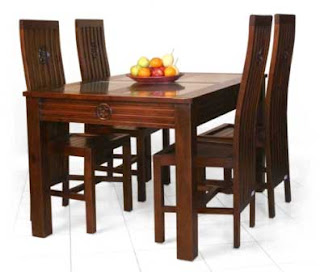
Artistic furniture products are usually made of wood with a choice of color and texture that works beautifully with the smooth completion of the final.
In the late 20th century, industrial art of Indonesia Furniture Handicraft from Jepara carving attract entrepreneurs from Western Europe, Asia and America to invest capital in the industrial sector. They have strong capital and broad market area. Generally they understand consumer preferences so that it can easily operate, produce and market their products to the user country. Foreign businessmen are generally very confident in the capabilities and skills of craftsmen from Jepara. Generally designs provided by foreign businessmen because they know the exact tastes of consumers in regions of origin. ( read Furniture Buying Guide )
Activities include arts and crafts industry has developed into a sculptural furniture event of competition between local and foreign entrepreneurs, as well as test vehicles to face the open market. Various challenges that arise should be arrested by local entrepreneurs as an opportunity to enhance the sculptural furniture industry. such as improving the quality of :
Jepara is Wholesale Marketplace in Indonesia. In turn will prove that the industry of Jepara furniture sculpture was included in the traditional art that can compete with similar industries in international forums. So artisans and craft industry products from Jepara is the potential that has been proven in global competition through the creation of a new creation coincided with the relocation of industries furniture carved from Western Europe.
 Indonesia Furniture Handicraft Wholesale Marketplace, support for outofindonesia.com
Indonesia Furniture Handicraft Wholesale Marketplace, support for outofindonesia.com
READ MORE - Indonesia Furniture Handicraft Wholesale Marketplace

- Wood Furniture
- Bamboo Furniture
- metal Furniture
- plastic and others.
Artistic furniture products are usually made of wood with a choice of color and texture that works beautifully with the smooth completion of the final.
Indonesia Furniture Handicraft
As far as furniture Indonesian furniture industry still has great prestige in world trade. In his solo exhibition, titled "Indonesia Pavilion" which lasted for 18 to 22 March 2007 in China, the furniture from Indonesian in great demand by international buyers. There were about 50-70 buyer has asked Indonesian businessmen to become suppliers of furniture and handicraft Indonesian transaction value of approximately U.S. $ 100 million.The government has also undertaken efforts to develop the furniture industry. In addition this sector has been adopted by the Government as one of 10 leading commodity export nation. This is supported by the design aspects and quality of products demanded by consumers overseas, the availability of raw materials and human resources ably. in Indonesia so many appeared more and more small or large traders trying to earn money from the furniture handicraft industry.Indonesia Wholesale Marketplace
One example is Jepara. Jepara is a small town located on the north coast of Java. Today, Jepara better known as a center for furniture wood carving handicraft industry, type of activity an art guild tradition has evolved into one business unit or a strong industry. The result of the product has entered the area of marketing, both at the local, national, regional, and international organizations, among others, on five continents, namely Asia, Africa, Australia and Europe.In the late 20th century, industrial art of Indonesia Furniture Handicraft from Jepara carving attract entrepreneurs from Western Europe, Asia and America to invest capital in the industrial sector. They have strong capital and broad market area. Generally they understand consumer preferences so that it can easily operate, produce and market their products to the user country. Foreign businessmen are generally very confident in the capabilities and skills of craftsmen from Jepara. Generally designs provided by foreign businessmen because they know the exact tastes of consumers in regions of origin. ( read Furniture Buying Guide )
Activities include arts and crafts industry has developed into a sculptural furniture event of competition between local and foreign entrepreneurs, as well as test vehicles to face the open market. Various challenges that arise should be arrested by local entrepreneurs as an opportunity to enhance the sculptural furniture industry. such as improving the quality of :
- materials
- processes
- production
- marketing
- packaging
- distribution and
- other services require programmed, integrated and sustainable.
Jepara is Wholesale Marketplace in Indonesia. In turn will prove that the industry of Jepara furniture sculpture was included in the traditional art that can compete with similar industries in international forums. So artisans and craft industry products from Jepara is the potential that has been proven in global competition through the creation of a new creation coincided with the relocation of industries furniture carved from Western Europe.
Jepara - Until now, the Jepara wood furniture and crafts are still facing the same problem after a few years ago haunt scarcity of raw materials is the center of the largest furniture industry.Indonesia Furniture Handicraft Wholesale Marketplace
In Komda site, and the Association of Indonesian Furniture Handicraft Industry (Asmindo) Jepara, Jepara written for a foreign country is one - the only region of the world's largest furniture. Regions furniture that occur naturally, from the traditions, culture and long history. When other areas such as Solo, Semarang, Malaysia or the roll - forming dense areas of furniture, Jepara furniture has become a region.
Even Jepara always be the object of research and comparative studies. Unfortunately, while the community was too late to anticipate areas of Jepara furniture and other countries emerged as competitors. When Indonesia and Jepara furniture products - more specifically - has decreased competitiveness, crowded - crowded, we yelled "we began to shortage of raw materials, human resources we are weak, the bureaucracy and we can not support costs, and interest rates are still significantly higher compared to other countries. "
complaint was written in 2005 at Jepara Komda site. Now the complaint is still real. Nothing different.
Supply constraints of raw material for making sculptures of furniture production volume of RA Kartini hometown drastically decreased.
According to the Regent of Jepara furniture industry Hendro Martoyo and woodworks in region every day requires approximately 600-800 m3 of wood as raw material.
Based on data from the Ministry of Industry (Industry), Jepara carving Mabel production volumes down from as many as three million sets at 2005-2700000 set in the year 2006.
Regent also said that in addition to experiencing supply constraints of raw materials, manufacturing and crafting wooden furniture from Jepara is also facing problems of low quality and competitiveness of their products in international markets. It happened because during the Jepara furniture product design in general still depend on the order of the buyer and the technologies used are still traditional.
Minister of Industry (Industry Minister), Fahmi Idris, in his working visit to the woodcraft center Mulyoharjo, Jepara, Central Java, recently said that growth in the furniture and wood processing industry in Indonesia today is still a minus three percent. That's because the problem of rampant illegal logging practices that make furniture and wooden handicrafts industry experienced raw material supply constraints and a negative image on the international market.
support Indonesia Furniture Handicraft Wholesale Marketplace
READ MORE - restore the glory of Jepara furniture handicraft industry
In Komda site, and the Association of Indonesian Furniture Handicraft Industry (Asmindo) Jepara, Jepara written for a foreign country is one - the only region of the world's largest furniture. Regions furniture that occur naturally, from the traditions, culture and long history. When other areas such as Solo, Semarang, Malaysia or the roll - forming dense areas of furniture, Jepara furniture has become a region.
Even Jepara always be the object of research and comparative studies. Unfortunately, while the community was too late to anticipate areas of Jepara furniture and other countries emerged as competitors. When Indonesia and Jepara furniture products - more specifically - has decreased competitiveness, crowded - crowded, we yelled "we began to shortage of raw materials, human resources we are weak, the bureaucracy and we can not support costs, and interest rates are still significantly higher compared to other countries. "
complaint was written in 2005 at Jepara Komda site. Now the complaint is still real. Nothing different.
Supply constraints of raw material for making sculptures of furniture production volume of RA Kartini hometown drastically decreased.
According to the Regent of Jepara furniture industry Hendro Martoyo and woodworks in region every day requires approximately 600-800 m3 of wood as raw material.
Based on data from the Ministry of Industry (Industry), Jepara carving Mabel production volumes down from as many as three million sets at 2005-2700000 set in the year 2006.
Regent also said that in addition to experiencing supply constraints of raw materials, manufacturing and crafting wooden furniture from Jepara is also facing problems of low quality and competitiveness of their products in international markets. It happened because during the Jepara furniture product design in general still depend on the order of the buyer and the technologies used are still traditional.
Minister of Industry (Industry Minister), Fahmi Idris, in his working visit to the woodcraft center Mulyoharjo, Jepara, Central Java, recently said that growth in the furniture and wood processing industry in Indonesia today is still a minus three percent. That's because the problem of rampant illegal logging practices that make furniture and wooden handicrafts industry experienced raw material supply constraints and a negative image on the international market.
support Indonesia Furniture Handicraft Wholesale Marketplace
http://www.tiarajeparamebel.com
Apabila anda sudah sangat ingin memiliki Blackberry karena kebutuhan tentunya, namun budget anda tidak menyukupi. Tidak usah risau atau gelisah, karena sekarang banyak sekali beredar “Blackberry Second”. Anda bisa mempertimbangkannya. Sama seperti handphone second lainnya, anda harus selalu hati-hati dalam memilih Blackberry second, apalagi kalau sebelumnya belum pernah memakai Blackberry. Jika anda adalah newbie Blackberry, maka ketika berburu Blackberry second saya sangat anjurkan untuk mengajak teman yang bener-bener mengerti tentang Blackberry.
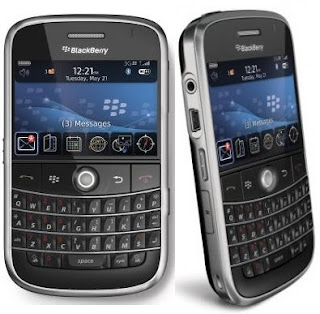
Berikut adalah cara pintar bagaimana memilih Blackberry Second yang benar :
1. Cek kondisi fisik Blackberry, lihat appearance Blackberry, apakah ada cacat minor atau major.
2. Cek keypadnya, apakah masih berfungsi dengan baik atau tidak ?
3. Cek kelengkapan, seperti buku, manual, headset, original charger, holster dsb
4. Cek no PIN dan IMEI yang ada di status, cek dengan pencet bersamaan tombol Alt+Shift+H, lalu dicocokkan dengan stiker belakang (didalam handheld, harus membuka baterai). Jika berbeda jangan dibeli! Ada kemungkinan Blackberry tersebut merupakan Blackberry cloning atau daur ulang
5. Cek vendor ID (kode khusus operator yang diberikan oleh RIM kepada operator
partnernya). di menu utama tahan tombol alt+Caps+h (qwerty), untuk Suretype tahan
tombol alt dan ketik RACE. Vendor ID ini HARUS 3 digit. jika bertemu -1 batalkan
niat untuk meminangnya. apa arti -1? berarti handheld tsb merupakan tester atau
EU (evaluation Unit). terkadang OK tetapi lebih baik pikir dua kali bagi anda yang
masih pemula.
6. Cek apakah handheld tersebut bisa digunakan oleh semua operator atau tidak.
7. Mintalah garansi ke toko ybs.
Selamat berburu Blackberry Second ya…
sumber http://www.beritaterkinionline.com
READ MORE - cara pintar memilih blackberry second

Berikut adalah cara pintar bagaimana memilih Blackberry Second yang benar :
1. Cek kondisi fisik Blackberry, lihat appearance Blackberry, apakah ada cacat minor atau major.
2. Cek keypadnya, apakah masih berfungsi dengan baik atau tidak ?
3. Cek kelengkapan, seperti buku, manual, headset, original charger, holster dsb
4. Cek no PIN dan IMEI yang ada di status, cek dengan pencet bersamaan tombol Alt+Shift+H, lalu dicocokkan dengan stiker belakang (didalam handheld, harus membuka baterai). Jika berbeda jangan dibeli! Ada kemungkinan Blackberry tersebut merupakan Blackberry cloning atau daur ulang
5. Cek vendor ID (kode khusus operator yang diberikan oleh RIM kepada operator
partnernya). di menu utama tahan tombol alt+Caps+h (qwerty), untuk Suretype tahan
tombol alt dan ketik RACE. Vendor ID ini HARUS 3 digit. jika bertemu -1 batalkan
niat untuk meminangnya. apa arti -1? berarti handheld tsb merupakan tester atau
EU (evaluation Unit). terkadang OK tetapi lebih baik pikir dua kali bagi anda yang
masih pemula.
6. Cek apakah handheld tersebut bisa digunakan oleh semua operator atau tidak.
7. Mintalah garansi ke toko ybs.
Selamat berburu Blackberry Second ya…
sumber http://www.beritaterkinionline.com
bantuin barang dagangan temen nic, ayo gan liat dulu..siapa tau berminat...


Spesifikasinya :
- yamaha Rxz th 91
- cat mulus
- tromol depan ninja
- velg Ride-it
- knalpot kolong garing (hand made)
- untuk detailnya lihat gambar aja ya sob...
Dijual Rp 5jt nego tipis deh....
jika ada yang berminat silahkan hubungi saya di nomer 0818 021 680 85
atau Via email indra_andriyadi@yahoo.com
Status barang : Sold Out
Bandung Only
READ MORE - Jual Rxz


Spesifikasinya :
- yamaha Rxz th 91
- cat mulus
- tromol depan ninja
- velg Ride-it
- knalpot kolong garing (hand made)
- untuk detailnya lihat gambar aja ya sob...
Dijual Rp 5jt nego tipis deh....
jika ada yang berminat silahkan hubungi saya di nomer 0818 021 680 85
atau Via email indra_andriyadi@yahoo.com
Status barang : Sold Out
Bandung Only
buat sobat-sobat yang demen motor antik monggo dilihat dagangan ane....
kali ini saya akan Jual CB 100, biar lebih afdol lihat gambar aja ya sob.



Spesifikasinya sebagai berikut :
- cb 100 th 79
- ban baru
- cat baru
- cdi
- mesin adem ayem tentrem
Dijual Rp 3,5jt nego tipis deh....
jika ada yang berminat silahkan hubungi saya di nomer 0818 021 680 85
atau Via email indra_andriyadi@yahoo.com
Status barang : Sold Out
Bandung Only
READ MORE - Jual CB 100
kali ini saya akan Jual CB 100, biar lebih afdol lihat gambar aja ya sob.



Spesifikasinya sebagai berikut :
- cb 100 th 79
- ban baru
- cat baru
- cdi
- mesin adem ayem tentrem
Dijual Rp 3,5jt nego tipis deh....
jika ada yang berminat silahkan hubungi saya di nomer 0818 021 680 85
atau Via email indra_andriyadi@yahoo.com
Status barang : Sold Out
Bandung Only
